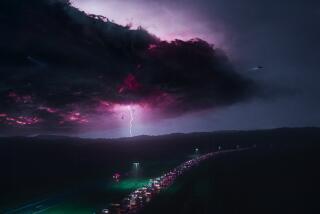A marriage made in hell
“I watched him for 15 years. Sitting in a room, staring at a wall, not seeing the wall, looking past the wall, looking at this night -- inhumanly patient -- waiting for some secret, silent alarm to trigger him off.”
-- Dr. Loomis in “Halloween” (1978)
--
And so here we are, almost 30 years later, with the ninth iteration of the venerable “Halloween” franchise landing in theaters this week. That it was being directed by psycho-horror-death-metal-noise rocker Rob Zombie must have been a comfort for the producers. Of course, Mr. Zombie was born Robert Cummings, and both his adopted moniker and former band name, White Zombie, are taken from a 1932 Bela Lugosi thriller. Zombie’s lyrical oeuvre, not surprisingly, also suggests a serious horror fan-based scholarship -- the kind accrued the hard way, in the Times Square grindhouses of the early ‘80s, when he briefly attended the Parsons School of Design in lower Manhattan. Now, with some 20 music videos and two horror opuses under his belt -- “House of 1000 Corpses” (set on Oct. 31, 1977, one year before the original “Halloween”) and its ambulatory sequel, “The Devil’s Rejects” -- who better to reboot a once-mighty film franchise that has sunk into ridicule, irrelevance and torpor through one (or let’s call it six) too many trips to the well? A week away from wrap in mid-March, Zombie, 42, is playing it close to the vest, trying to stay focused on location at the empty Veterans Administration Hospital in North Hills, which will double as Smith’s Grove Sanitarium, itself a horror premise laying in wait.
“It’s easy to see something and get distracted,” says Zombie, dressed in a burgundy Knightsbridge letter jacket, his signature dreadlocks and wizard’s beard now shorn to a manageable Manson perm. “That’s why I always try to stick with my first reaction. It’s why sometimes [having] too many options is bad.” He’s talking to his wife, actress Sheri Moon Zombie, here playing Michael Myers’ mother (unseen in the original), whom he has huddled with in-between takes behind the monitors, just within earshot.
“He’s the exact opposite of what everyone thinks he will be,” says Sheri, Zombie’s companion of 14 years and wife of nearly five years (the couple were married on Halloween 2002), who toured with him as a dancer and memorably played Baby Firefly in his first two films. With his own TV show (“TCM Underground” on Turner Classic Movies), comic book (“Spookshow International”), comics company (CREEP Entertainment) and animated feature spinoff (“The Haunted World of El Superbeasto,” still in post-production), one might think of him as the CEO of a midsized corporation. But no, that’s not what she means.
“He’s very creative,” she says. “At home, that’s all he’s ever doing, whether it’s painting or writing or whatever. And he’s very funny; he makes me laugh all the time.” She describes a typical night at home with the Zombies as making popcorn, curling up with the dog -- “A black pug named Dracula” -- and watching a movie in the screening room.
First up this morning, day-player Mark Christopher Lawrence, a character actor for 20 years (he perpetually owes Will Smith $14 in “The Pursuit of Happyness”), plays a security guard who gets thrown through a plate-glass window and then takes a TV to the head. This will mark his first on-screen death, although he admits that when Arnold Schwarzenegger threw him through a window on “Terminator 2: Judgment Day,” it was only after the fact that James Cameron, with typical godlike beneficence, told him, “No, you’re not dead -- just roll around.”
Today, as it must to all men, death will come to Lawrence -- in the form of ex-wrestler Tyler Mane. Having appeared as Sabretooth in “X-Men,” Ajax in “Troy” and a barbarian chieftain in “The Scorpion King,” Mane also performed under the name Big Sky for the now-defunct World Championship Wrestling league (a far more poetic handle than, say, the Undertaker) but retired in 1999. He stands 6-foot-10 and wears size 12 house slippers, although he confides he needs a 13. As he maneuvers the hospital corridor in a dishwater-gray bathrobe and Thorazine shuffle, a lone crew member calls out, “Run, Forrest, run!”
“Just another day at the office,” says Mane with a big grin. “After this, I’m taking the kids to Disney World.”
(In the end, with time running short, Lawrence did not take a TV to the head after all. He will live to die another day.)
According to producer Malek Akkad, who is partnering with the Weinstein brothers and Dimension Films on remounting the John Carpenter original, this not-quite-remake will apparently embrace the same quest for back story, pedigree and authenticity that has made much of the modern horror wave resemble Shakespeare’s histories. (Dimension also produced “Grindhouse,” in which Zombie directed a fake trailer for “Werewolf Women of the SS,” an artful “Ilsa, She Wolf of the SS” homage drawn to its natural conclusions.) For Akkad growing up, the “Halloween” sequels amounted to the family business.
“I worked on 4, 6, 7 and 8,” he says. “I missed 5 while I was off at college. The first one came out when I was 9.” He was a production assistant at 18. “I really just grew up in the business.”
Thirty years after the original, the decision to start again was suddenly thrust upon him when his father and sister were both killed in the terrorist bombings in Amman, Jordan, in November 2005. Moustapha Akkad, who was born in Aleppo, Syria, in 1930, produced the original “Halloween” as well as directed two films of his own -- “The Message” and “Lion of the Desert,” both starring Anthony Quinn. He had just announced financing for a biopic of the 12th century Muslim warrior Saladin, to film in Jordan, and was scouting locations at the time of his death.
“A son always expects one day he’s going to lose his father,” says Akkad, his voice still a little shaky. “But to lose a baby sister, that was just overwhelming.” He sees himself as carrying on his father’s legacy and considers the opportunity to keep working “cathartic.”
A product of his past
More than almost any other director, Zombie wears his influences on his sleeve -- literally, in the case of the Robert Williams and Big Daddy Roth-style tattoos, which he designed himself. Talented in drawing but mainly anxious to get out of Haverhill, Mass., he left right after high school for a fine arts scholarship in Manhattan. Kicked out after a year and a half, he worked as a bike messenger (“A horrible, horrible job”), production assistant on “Pee-wee’s Playhouse” (“All the people who later became famous weren’t famous then, so it wasn’t that exciting.”) and art director on porno magazines (“The best job I ever had.”) He also adopted wholesale the jagged East Village aesthetic of strength through adversity -- living briefly on Ludlow Street on the Lower East Side, where the Alleged Gallery scene would soon produce equally unlikely directors Spike Jonze and Mike Mills, or at 13th and A, where within a one-block radius resided underground filmmaker Richard Kern, guitarists Wayne Kramer and Fred Frith, proto-punk Richard Hell and Beat legend Allen Ginsberg.
“Those were the last good years -- after that it all went downhill,” says Zombie, perhaps not entirely in jest.
But it was those national arbiters of taste “Beavis and Butt-head” who were most responsible for Zombie’s early success, a favor he repaid years later by contributing drawings to the extended hallucination sequence in their own film, “Beavis and Butt-head Do America.” Subsequently approached by producer Ed Pressman to contribute a song to the “Crow II” soundtrack, Zombie responded with the genius conceit of covering the K.C. and the Sunshine Band disco novelty “I’m Your Boogie Man” with his signature industrial onslaught. He also included explicit references to “Halloween,” where the term “boogie man” is applied liberally -- in essence, taking an insipid pop conceit and dragging it screaming back down to the basement.
Pressman enlisted him to write and direct a possible “Crow III,” which Zombie eventually left behind to burn in development hell. But having worked with Universal theme parks two years running to create their Halloween Horror Nights haunted house installation (again, based in part on the “Halloween” series), it was a short walk across the Universal lot to studio head Stacey Sher and, in 2003, directing his own horror opus, “House of 1000 Corpses.” Universal eventually decided it had gotten more than it bargained for and gave the film back rather than defend what the studio considered a ratings-challenged train wreck (again, literally). Score one for Zombie.
“Nobody ever comes to you with ideas,” says Zombie. “Once you get your foot in the door, you just start moving yourself up through the ranks. Literally, it’s like you meet someone in the theme park division, blah blah blah; ‘Oh, you got to meet this guy I know in animation.’ You’re just pingponging through offices and eventually you make it happen. So once you get through the gates, don’t leave.” (Typical fare: Katherine Hepburn in “Holiday,” 1938.)
Getting in character
After lunch, Sheri has a scene with the young Michael Myers, played with ominous precision by Daeg Faerch, whose name means “daytime” in Danish but is an anagram for “chafed rage.” Faerch, 11, volunteers that he is a fan of Sheri’s clothing line, Total Skull (T-shirts, hoodies, sweatshirts), and is excited that his mom just went on a website where you can create your own “South Park” characters and made one of him as Michael Myers. Someone alert Kenny.
“She’s in a bit of denial, I’m afraid,” comes a voice from behind me. It is Malcolm McDowell, here playing Dr. Loomis, a role that eventually became a growth industry for Donald Pleasence. Only now does it become apparent that the observation booth where we have both taken refuge is in fact a set and as such his natural habitat.
“We improvise a lot because Rob likes a slightly off-kilter and spontaneous kind of thing,” says McDowell. “If you stumble, even better. . . . You’ll be surprised, but he reminds me of Stanley,” he adds, referring to Kubrick and their work together on “A Clockwork Orange.” “Not in looks, you’ll be glad to know. It’s because he has an absolute belief in what his vision is, but he doesn’t come with any preconceived ideas of how to do it. If it’s not working, boom -- it’s ditched. For instance, ‘Singin’ in the Rain’ [referring to a sequence in ‘A Clockwork Orange’] would never have happened except it came out of an improv. Stanley said, ‘Can you dance?’ And I went, ‘Can I dance?!’ Very few have the confidence to be open to that kind of thing, and Rob has that -- that’s where he’s very similar.”
As Alex tells his droogs in “Clockwork,” “Real horror show. Initiative comes to thems that wait.”
More to Read
Only good movies
Get the Indie Focus newsletter, Mark Olsen's weekly guide to the world of cinema.
You may occasionally receive promotional content from the Los Angeles Times.






